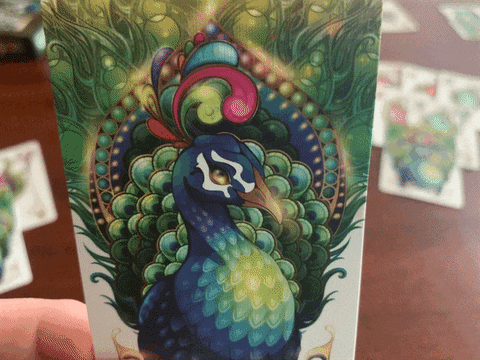:strip_icc()/pic6134533.jpg)
Here's an overview of this 3-6 player game from Gérald Cattiaux and Dixit designer Jean-Louis Roubira:
Stella is a competitive game in the Dixit universe. In each round, players interpret Dixit cards on a board after receiving a common clue word. Each player observes the Dixit cards and secretly associates these cards with the clue word, marking on their erasable personal slates the cards that they choose. Selecting the same cards as the other players allows you to score more points. Conversely, selecting a card that no one else chooses may cost you dearly.
At the end of the fourth round, each player calculates their total score. Whoever has the most points — which is possibly more than one person — wins.
In The Artemis Odyssey, players guide their faction through the galaxy, discovering planets and using their resources. Your starships will land on uninhabited worlds, establish colonies, develop people, and build starships. Each player controls a faction through their action cards. You play your cards to a shared planning board, then those cards are revealed and executed in sequence during the action phase.
When a player crosses the 77-point threshold or when all planets have been explored, the game ends and the player with the most points wins.
I've played Think Str8! and thought it extremely clever — but the German publisher HUCH! lacked U.S. distribution, and that game's graphic design and production were somewhat lackluster, making it easy to overlook on a market crowded with beautiful games. The Lost Code seems like it will have a nicer production, with plastic components rather than thin paper cards that allowed you to see the numbers through them. Why is that important?
Here's an overview of how to play the original game as it's not clear how much The Lost Code will differ from what's come before:
In more detail, the game includes cards in six colors, with each color having numbers 0-7. One card of each color is randomly removed from play and returned to the box without anyone knowing the numbers on those cards. Each player then sets up a rack with one card of each color on it, but with the racks facing toward the other players so that no one sees the numbers on their own rack. (In a game with two or three players, set up two or one additional racks visible to all players.)
On a round, the active player rolls the three color dice, e.g., blue, red, and yellow. Each player tries to guess what the sum of the numbers on their rack is for the cards that correspond to the die colors. If the dice showed two green and one grey, for example, you'd add the green number twice and the grey number once — but of course you can't see what your numbers are; you can only see what they aren't based on what's showing in the racks visible to you.
The active player then takes one of the bid strips — seven cardboard strips that come in different lengths — and places it across one or more numbers on the number line in front of them to show the range in which their sum lies, e.g., 13-16. Each other player does the same, choosing from the strips not previously chosen. If you guess correctly, you score points, with shorter strips being worth more points; if you're wrong, then you must discard any one of your colored cards face up, then draw a new card of this color and place it in your rack unseen. You now see this hidden number, which may help you deduce sums from previous rounds, but now you have to start over with you deductions for that color! Other players see the new card you just placed, so they get more info, too.
After 8-10 rounds, depending on the number of players, each player guesses the numbers on their racks, writing down one, two, or three guesses for each color. If you guess correctly, you score 5, 2, or 1 points for a color based on how many guesses you wrote. Add these points to whatever you scored previously, and whoever has the most points wins.



:strip_icc()/pic6195073.png)
/pic383353.jpg)
:strip_icc()/pic6211069.jpg)
/pic2367592.jpg)
:strip_icc()/pic5194215.jpg)
:strip_icc()/pic6240238.jpg)

:strip_icc()/pic6237488.jpg)
:strip_icc()/pic6231474.jpg)
/pic5212561.png)
